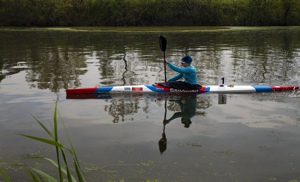Canoe Sprint Rules

Canoe Sprint is a water sport where athletes race long boats (either canoes or kayaks) across calm water, attempting to reach the finish line in the fastest time possible.
Canoeing for recreational and sporting purposes is a relatively recent development, having grown popular in at the turn of the twentieth century. For many years, canoes were simply boats used for travelling, whereas kayaks were originally carved by Eskimos for hunting purposes.
Canoe Sprint has been an Olympic event ever since 1936. The sport originally began as a men’s only competition, but by 1948 women's Canoe Sprint events were introduced into the Olympic program.
German, Birgit Fischer, is considered to be the best Canoe Sprint athlete in history, having amassed an impressive 8 gold and 4 silver medals during a long and illustrious playing career. Europe as a whole has completely dominated Canoe Sprint events, with an astonishing 90% of all Olympic medals going to European countries since 1936.
Object Of The Game
The objective of Canoe Sprint is a simple one: to reach the finish line in the fastest possible time. Canoe Sprint can be performed in either a canoe boat or a kayak boat with a number of different competitors inside and across varying degrees of distance.
There are currently twelve different events for Canoe Sprint at the Olympics, which are all listed below. The letter denotes the type of boat used (“C” for canoe, “K” for kayak) and the number signifies the amount of athletes competing in that boat:
- Men’s C-1 200 metres
- Men’s C-1 1000 metres
- Men’s K-2 1000 metres
- Men’s K-1 200 metres
- Men’s K-1 1000 metres
- Men’s K-2 200 metres
- Men’s K-2 1000 metres
- Men’s K-4 1000 metres
- Women’s K-1 200 metres
- Women’s K-1 500 metres
- Women’s K-2 500 metres
- Women’s K-4 500 metres
Players & Equipment
The specific equipment used in a Canoe Sprint event depends on the length of the race, the type of race and also the number of participants involved.
Canoes – Canoe Racing Events
Canoe boats are pushed and steered through the water using a paddle with a single blade, with athletes positioning themselves on one knee whilst placing the opposite leg in front of them for maximum stability and control. Most Canoe Sprint boat paddles are constructed with a wooden handle for strong grip, a carbon fibre shaft and a carbon fibre blade.
Kayak – Kayak Racing Events
Kayak boats are pushed through the water using a paddle with a double blade with athletes using their feet to steer the boat via a rudder. Paddles used for kayak sprint boats are typically constructed with carbon fibre material and/or fibreglass.
Lanes
Each boat in Canoe Sprint is assigned their own lane, which they must rigidly stick to throughout the race. Any boat that drifts outside of a 5-metre boundary will risk being disqualified.
Scoring
There is no scoring process in place in Canoe Sprint. It is simply a case of powering the boat to reach the finish line in the fastest possible time in order to win the race. Races can sometimes be neck-and-neck right up until the end and when this happens it may require a “photo finish” to determine which athlete/team won the race. Whichever boat’s bow (tip or end of the boat) crosses the line first is awarded the win.
Winning
The winner of a Canoe Sprint race is the athlete/team that reaches the finish line first. In the Olympics, there are initially a series of “heat” races held. The better the athlete/team performs in the heats, the greater chance they have of making it to the final race, where the boat that crosses the finish line before any other is awarded the gold medal.
Winners of a heat or semi-final will be assigned the central lanes in the subsequent races. If there is a tie between two boats, both will progress to the next race, with one of the boats competing in the spare lane known as the “0” lane. If there are not enough lanes to accommodate all boats, the boats that tied will compete in another race to determine who will go through. If there is a tie in the final, both athletes/teams will be awarded gold.
Rules of Canoe Sprint
- Canoe Sprint races take place over 200 metres, 500 metres and 1000 metres.
- Lanes are assigned depending on performances in the heats. The winners are awarded the centre lanes, which are deemed to be slightly advantageous.
- In team events, no members of the crew can be swapped at any time, regardless of injury, illness or any other mitigating factors. Any team or athlete who cannot perform for any reason will be disqualified.
- Committing any of the following fouls may result in a warning or complete disqualification:
- Arriving late for the race
- Missing a race
- Committing two false starts
- Breaking the 5-metre rule, which dictates that boats must remain inside a 5 metre boundary in their lane at all times
- All boats will also be subject to checks at the end of the race to ensure they have complied with pre-agreed rules and regulations. Any boat found to have failed to adhere to these rules (such as weighing in light) would be disqualified.
- An athlete or team is permitted to protest a caution or warning, but must do so immediately after the end of the race (20-minutes maximum) to the competition committee. The committee will make a prompt decision, and if the athlete/team does not agree with this ruling, they are allowed to then approach the jury within the next 20-minutes. Any ruling made by the jury is final.